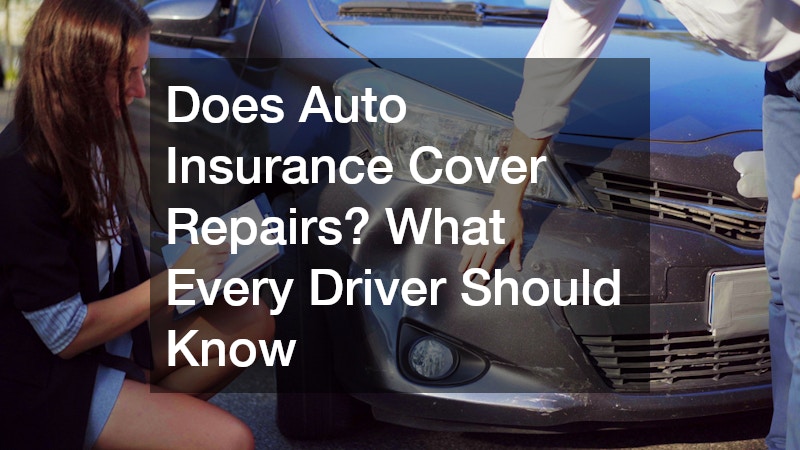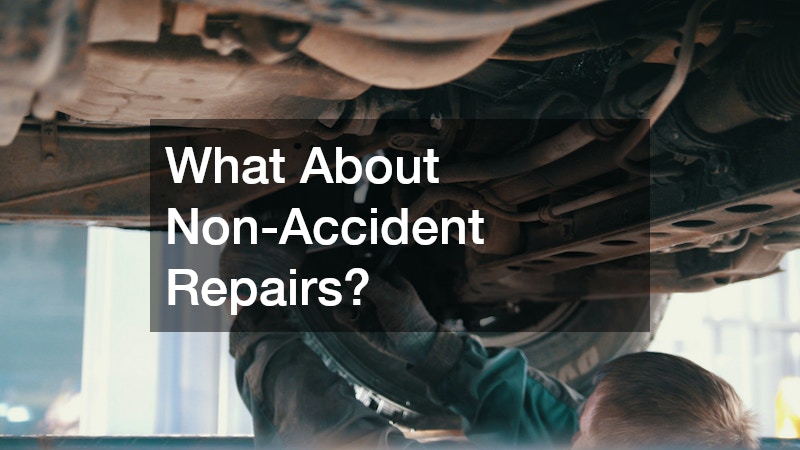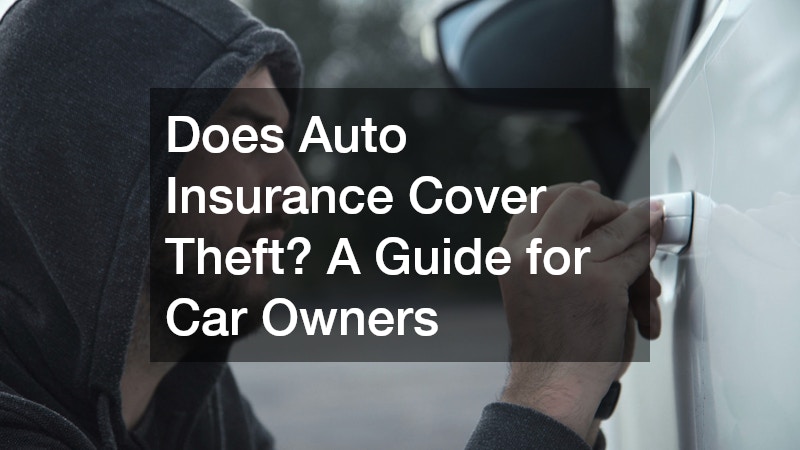
Owning a car comes with freedom, convenience, and responsibility. One of the most common questions car owners ask is: Does auto insurance cover repairs? The answer isn’t always straightforward. Coverage depends on the type of insurance you have, the nature of the damage, and who is at fault. In this comprehensive guide, we break down everything drivers need to know about auto insurance and repairs, so you’re never caught off guard at the repair shop.
From fender benders to engine trouble, we’ll explain what is covered, what’s not, and how to navigate the claims process. We’ll also cover tips for understanding your policy, when to pay out of pocket, and how to protect yourself financially in the long run.
Understanding the Basics of Auto Insurance
Before diving into which repairs are covered, it’s crucial to understand the types of auto insurance coverage available. Each type offers a different level of protection, and the kind of repairs covered will depend heavily on what you carry.
Key Types of Auto Insurance Coverage
- Liability Insurance: Required in most states. Covers damage and injuries you cause to others, not your own car.
- Collision Coverage: Pays for repairs to your vehicle after a crash, regardless of who’s at fault.
- Comprehensive Coverage: Covers non-collision events like theft, vandalism, fire, or weather damage.
- Uninsured/Underinsured Motorist Coverage: Helps cover your costs if the other driver doesn’t have enough insurance.
- Mechanical Breakdown Insurance (MBI): Optional and separate from traditional auto insurance. Covers major mechanical failures unrelated to accidents.
Understanding these distinctions helps clarify when your insurer is likely to step in for repairs, and when they won’t.
Does Auto Insurance Cover Repairs After an Accident?
Accidents are among the most common causes of car damage, and they’re also the most common triggers for insurance claims. But does that mean your repairs are always covered?
What’s Typically Covered After an Accident
- Collision Coverage: If you hit another car, a tree, a guardrail, or even a pothole, collision insurance usually pays for your car’s repairs.
- Other Driver’s Insurance: If the other driver is at fault, their liability insurance should pay for your repair costs.
- Uninsured Driver: If the other party is uninsured or flees the scene, uninsured motorist property damage coverage may kick in.
When Repairs May Not Be Covered
- You only have liability coverage, and you caused the accident.
- You failed to report the accident within the required time.
- Damage is cosmetic and doesn’t affect safety or function.
It’s vital to know your policy limits and deductibles. Even if a repair is covered, you’ll need to pay the deductible before insurance kicks in.
What About Non-Accident Repairs?
One of the most common misconceptions is that all repairs are covered under auto insurance. In reality, insurance generally does not cover repairs due to normal wear and tear or mechanical failure.
Common Scenarios Not Covered by Standard Policies
- Engine failure due to age or lack of maintenance
- Brake replacement
- Worn-out tires or suspension components
- Electrical system malfunctions unrelated to an accident
These are considered maintenance issues and are the owner’s responsibility. However, there are exceptions.
When Non-Accident Repairs May Be Covered
- If vandalism causes the damage: Comprehensive insurance can cover broken windows, slashed tires, or keyed paint.
- If a natural disaster occurs: Hail, flooding, or fallen trees may be covered under comprehensive insurance.
- If theft or attempted theft damages your vehicle: Repairs from forced entry or hotwiring are typically covered.
Does Auto Insurance Cover Repairs from Weather Damage?
Extreme weather events can wreak havoc on your car, and not all types of damage are created equal in the eyes of insurance providers.
Covered by Comprehensive Insurance
- Hailstorms: Dents and broken glass from hail are covered.
- Floods: If your car is submerged or waterlogged, repairs or even total loss claims are covered.
- Falling Objects: Tree branches, debris, or ice chunks can be covered under comprehensive insurance.
- Fires and Lightning: Damage from fire or electrical storms is also typically covered.
What’s Not Covered
- Gradual rust from repeated exposure to rain or salt.
- Damage from driving during a storm (if determined to be negligent).
- Any weather-related damage not addressed promptly could be denied due to neglect.
Tip: If you live in an area prone to severe weather, comprehensive coverage is highly recommended.
Does Auto Insurance Cover Repairs from Vandalism or Theft?
If your vehicle is vandalized or damaged in a break-in, comprehensive coverage is your best friend. These incidents are unpredictable and frustrating, but they are generally covered under the right policy.
Examples of Covered Vandalism Repairs
- Broken windows or windshields
- Slashed or stolen tires
- Spray paint or scratched paint jobs
- Stolen radios or catalytic converters (if part of the original vehicle setup)
Filing a police report is usually required to start a claim for theft or vandalism.
Does Liability Insurance Cover Repairs to My Own Vehicle?
Many drivers are shocked to discover that liability insurance does not cover their own car repairs. If you only carry the minimum required insurance in your state, you’re likely on your own when it comes to fixing your car.
Liability Only Covers:
- Bodily injury to others
- Damage to other people’s vehicles or property
To get your own repairs covered, you’ll need to add collision or comprehensive coverage to your policy. Without these, your insurer won’t pay for your vehicle’s repair, even if the damage was not your fault and the at-fault driver is unidentified or uninsured.
Understanding Deductibles and Limits
Even when your repair is covered by insurance, it’s not a free ride. You’re still responsible for:
Deductible
- The amount you pay out of pocket before insurance covers the rest.
- Common deductible amounts range from $250 to $1,000.
- Choosing a higher deductible often reduces your premium, but increases what you pay when repairs are needed.
Policy Limits
- The maximum amount your insurer will pay for a specific repair or total loss.
- Exceeding your coverage limit means paying the difference yourself.
Always read the fine print. A policy may seem like a good deal until you realize how much you’ll pay before coverage applies.
Does Auto Insurance Cover Engine or Transmission Repairs?
This is where many drivers get confused. Engine and transmission repairs can be expensive, so it’s natural to hope insurance will help. But auto insurance rarely covers these repairs unless damage is directly caused by a covered event.
When Engine/Transmission Repairs Are Covered
- Result of a covered collision
- Caused by vandalism or theft
- Damaged in a flood or fire
- Affected by falling debris or another external event
When They’re Not Covered
- Wear and tear
- Poor maintenance
- Manufacturer defects (covered by warranties instead)
If you’re concerned about mechanical breakdowns, you might consider Mechanical Breakdown Insurance (MBI) or an extended vehicle warranty.
How to File a Repair Claim with Your Auto Insurance
If your vehicle needs repairs due to a covered event, follow these steps for a smoother claims process:
Step-by-Step Claim Process
- Document the Damage
Take detailed photos and write a summary of what happened. - Contact Your Insurer Immediately
Most companies have deadlines for reporting. - File a Police Report (if applicable)
Required in cases of theft, vandalism, or serious accidents. - Get Repair Estimates
Some insurers require an approved mechanic; others allow you to choose. - Submit the Claim
Include all documents, photos, and repair estimates. - Pay Your Deductible
This must be paid before repairs begin unless the other driver is at fault. - Track and Follow Up
Stay in contact with your adjuster until the claim is closed.
When Should You Pay Out of Pocket Instead?
Not all damage is worth filing a claim. In some cases, paying out of pocket makes more financial sense.
Situations Where You Might Skip a Claim
- Repair cost is less than or just above your deductible
- It’s a minor cosmetic issue
- You want to avoid a possible rate increase
- You’ve filed multiple claims recently
Making too many small claims can result in a rate hike or even a dropped policy. Use your insurance strategically.
How to Protect Yourself from Uncovered Repairs
Proactive Steps for Car Owners
- Read your insurance policy thoroughly
- Regularly maintain your vehicle to avoid mechanical failures
- Keep detailed service records
- Consider optional add-ons like MBI or roadside assistance
- Review your coverage annually to ensure it meets your needs
Knowledge is your best defense. Knowing what’s covered—and what isn’t—prepares you for the unexpected and can save you thousands of dollars.
Can You Choose Your Own Trusted Repair Shop After Filing a Claim?
One of the most common concerns drivers have after an accident is whether they can take their vehicle to a trusted mechanic or if they’re required to use an insurance-approved repair shop. The good news is that most insurance companies allow you to choose your trusted repair facility, though there may be pros and cons to doing so.
Things to Consider When Choosing a Repair Shop:
- Direct Repair Program (DRP) Shops: These are pre-approved by insurers and often offer faster processing and guaranteed work.
- Independent Shops: You may prefer your own mechanic, but you’ll need to ensure the shop provides all the necessary documentation.
- Warranty Coverage: Some insurers only guarantee work done through DRP shops.
- Estimates and Inspections: The insurer may require an inspection or a second estimate if you choose an outside shop.
- State Laws: Your rights may vary depending on your state; some laws prohibit insurers from steering you to specific shops.
Always read your policy and ask your claims adjuster about your rights before making a decision.
Final Thoughts: Know Your Policy Before You Need It
So, does auto insurance cover repairs? It depends on the situation and your policy. Collision and comprehensive coverage offer protection for a wide range of repair scenarios, while basic liability coverage leaves you exposed when it comes to your own vehicle.
Understanding the ins and outs of your insurance policy is one of the smartest things you can do as a car owner. Take the time to review your current coverage, ask questions, and consider upgrading if needed. That way, you’ll be ready—financially and emotionally—when something goes wrong on the road.





